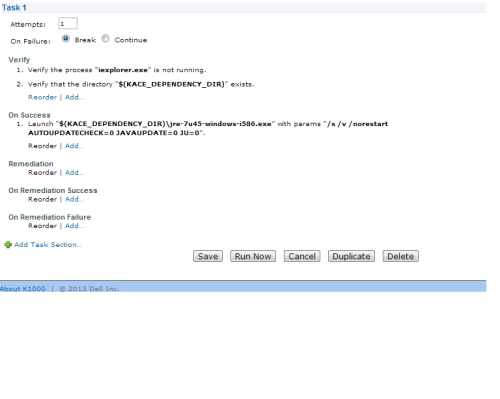Malfunction deploying software through KACE 1000
Hello Everyone!
I will start by saying I am a Junior System Admin with zero prior experience with Kace Management Center. I have been using the Center for about 4 weeks now and am slowly familiarizing myself. I am running into an issue with deploying software via the distribution function though. I have been trying to set up a software distro to install the newest Java update. I have created the new software under the inventory tab, with the following stats:
Name: Java Update 45
Publisher: Oracle
Display Version: 7 Update 45
Supported OS: Win7 Pro, Pro SP1, Pro x64 SP1
Current File associated: jre1.7.0_45.zip (contains both the .msi and .cab files)
I then went to managed installations under the distribution tab, chose new action from dropdown, and made a new install called Java 7 Update 45 Settings are as follows:
Installation command- Manual
This software will be installed via: msiexec /i jre1.7.0_45.msi
This software will only be installed on the following OS: Win7 Pro, Win7 Pro SP1, Pro x64 SP1
Software: Java 7 Update 45
Installation Command: msiexec /i jre1.7.0_45.msi
No checkboxes checked.
Managed Action: Execute anytime
Limit Deployment to Listed Machines: (the one machine I'm using for sandbox testing, OS: Win7 Pro)
Now my question is this: While this command works fine in the CLI, I can't get it to run if I use the /quiet or /qn or /passive options, because when I run it a prompt pops up and asks for elevated credentials. I was under the impression that msiexec ran in elevated mode already. So when I run quiet, it doesn't install. When I remove the option, it pops up, I'm allowed to enter credentials, and it installs perfectly. Doing some research I heard of creating an answer file for silent installs, is this the right path? Also, is there a command or option I can put in, such as the runas command?
Any help would be GREATLY appreciated, and thanks in advance for looking!
Spurpickle
-
When you say you created it, do you mean you created a custom inventory for it? You should install it on a test machine, and let Kace inventory it. - dugullett 10 years ago
-
Yes, I did create a custom inventory for it. I am in the process of building a script as suggested by jnox, but since i'm part time still I don't work weekends. I'll post my results by the end of the week. - SpurPickle 10 years ago
-
You should install the title manually on one system and then add the file to the software inventory item that KACE creates for it. - chucksteel 10 years ago
Answers (6)
http://www.itninja.com/blog/view/kace-install-java-7-update-11-using-a-script-removes-previous-versions http://www.itninja.com/question/using-k1000-and-managed-install-for-java-7u11-and-getting-pop-ups-during-silent-install These two posts should help you out. They did for me.
Managed installs use the local system account, which does not have admin rights. If you need admin rights in your environment, you would need to switch to an online kscript and use the run as function to provide admin rights.
Comments:
-
Thanks for the quick response jknox, I tried the managed installs route b/c KACE said it was the most simple. I am looking forward to getting back to work after the weekend and testing out your theory. For now, I have some research to do on scripting in general, so I have my work cut out for me! I'll come back and post how it goes, and thanks for the help! - SpurPickle 10 years ago
-
I'm not sure why you say the local system account doesn't have admin rights. If that was correct then you could never use a managed install to install software on a machine. - chucksteel 10 years ago
-
Fair enough, it has access to most system objects, but not all: http://msdn.microsoft.com/en-us/library/windows/desktop/ms684190%28v=vs.85%29.aspx - jknox 10 years ago
These two posts should help you out. They did for me.
Comments:
-
I did follow those links, and the first one was my template for my script. I ran it yesterday against two test computers (my own and a remote test PC) and it worked! I was having issues with UAC but they seemed to solve themselves after I removed them, restarted the target machine, then repeatedly ran the script/uninstalled while moving the UAC slider up. I left it at the second highest setting and it was still running successfully. Thank you! - SpurPickle 10 years ago
You have a manual command which includes the msiexec portion so you have to also check the box for "Don't prepend msiexec.exe" (you also say you don't have anything checked). If you include the msiexec.exe in your manual command (which I always do), then you also need to tell KACE not to prepend the command.
Comments:
-
Yeah that part threw me for a loop for a bit, but I did as you say and clicked the "Don't prepend msi.exe" box and was filling out the full command line with the msiexec included. - SpurPickle 10 years ago
One of the ways I install software like Java, is by targeting the system using Patching, and using the "full installer". This allows me to set up smart lables for the exact software patching level I want, and given enough parameters, installs the correct version. One thing that people forget about Patching is that you can actually use it to install full versions of software like Java, Firefox, and Flash.
By using the patching with Smart Labels, we can keep the current versions until the "new" versions are vetted and then push those out. Also by using this method, you can get all the necessary machines to the current version regardless of whether or not the software has ever been installed.
This approach is much less time consuming than building new installer packages every other week. It won't work for everything out there, but it is a useful trick.
Comments:
-
Thanks for the tip archangel, I'll have to play around with it. My supervisor (IT Director) has given me a 'sandbox' PC to play around with so that I can get familiar with KACE and other software/services we use. I am currently running through learning different methods of install/uninstall via KACE, GPO, etc. Better to know multiple methods to complete the mission in case one is not plausible. - SpurPickle 10 years ago
-
Not having to worry about updating all the updater scripts is the #1 reason I've settled on this method for any/all software I can is reason enough. I don't have time to constantly locate, update, manage or otherwise have to deal with programs we have to tolerate (like Java ugghhh).
We've stopped distributing software via GPO because of the boot times is huge. Exception is .. KACE agent. Everything else is done via KACE. Using Patches to install software means I don't have to worry about managing versions in inventory, or updating scripts.
I saw that you have chosen using scripting to do the installs. Personally, I wouldn't use scripts to install software, simply because of the time it takes to keep them updated. Java gets updates all the time, keeping that updated alone would be tiresome.
Software I cannot install via Patching, I use Software Inventory/Distribution to install. Some packages require prerequisite software installed, and with smart labels I can get those packages built, and smart labels designed so that software doesn't get installed unless the prerequisites are met. It also helps make sure that software doesn't get accidentally installed on SERVER based OSes.
Our team manages 5500 computers and 80+/- servers across 19 campuses with a staff of 12. Time is really important to us. - archangel michael 10 years ago-
Roger that Archangel, I can see why you would want the most efficient, least hand-held approach. The main reason I started with the scripting is what I found here on ITninja, but I was able to install using both Managed Installations and also script, and I have perused the patch function in KACE in my free time. I guess this grand experiment has been to continue becoming comfortable with KACE, and broaden my areas of knowledge. FYI, we also use the patch manager to handle 90% of our software updates, but my IT Director wanted me to stretch my wings a bit, if you'll forgive the angel pun. :D - SpurPickle 10 years ago
Thank you for the assistance everyone, and I am proud to say as of last night, my script was finally successful! Here is my deployment method and options selected:
Script-Java Update (current version: 7u45)
Type:Online Kscript
Status: Production
Enabled: Yes
Runas: Local System
Target: Test machine
Scheduling: Don't run on a schedule
Allow to run while logged off: yes
Dependencies: jre-7u45-windows-i586.exe

I just want to say thank you everyone for your input, and I hope this helps others like me out in the future! Now, on to the next task in the giant mountain of work that is IT. :)








